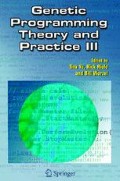Abstract
Standard Genetic Programming operators are highly disruptive, with the concomitant risk that it may be difficult to converge to an optimal structure. The Tree Adjoining Grammar (TAG) formalism provides a more flexible Genetic Programming tree representation which supports a wide range of operators while retaining the advantages of tree-based representation. In particular, minimal-change point insertion and deletion operators may be defined. Previous work has shown that point insertion and deletion, used as local search operators, can dramatically reduce search effort in a range of standard problems. Here, we evaluate the effect of local search with these operators on a real-World ecological time series modelling problem. For the same search effort, TAG-based GP with the local search operators generates solutions with significantly lower training set error. The results are equivocal on test set error, local search generating larger individuals which generalise only a little better than the less accurate solutions given by the original algorithm.
Access this chapter
Tax calculation will be finalised at checkout
Purchases are for personal use only
Preview
Unable to display preview. Download preview PDF.
References
Cramer, Nichael Lynn (1985). A representation for the adaptive generation of simple sequential programs. In Grefenstette, John J., editor, Proceedings of an International Conference on Genetic Algorithms and the Applications, pages 183–187, Carnegie-Mellon University, Pittsburgh, PA, USA.
Daida, Jason M., Li, Hsiaolei, Tang, Ricky, and Hilss, Adam M. (2003). What makes a problem GP-hard? validating a hypothesis of structural causes. In Cantú-Paz, E., Foster, J. A., Deb, K., Davis, D., Roy, R., O’Reilly, U.-M., Beyer, H.-G., Standish, R., Kendall, G., Wilson, S., Harman, M., Wegener, J., Dasgupta, D., Potter, M. A., Schultz, A. C., Dowsland, K., Jonoska, N., and Miller, J., editors, Genetic and Evolutionary Computation — GECCO-2003, volume 2724 of LNCS, pages 1665–1677, Chicago. Springer-Verlag.
Geyer-Schulz, Andreas (1995). Fuzzy Rule-Based Expert Systems and Genetic Machine Learning, volume 3 of Studies in Fuzziness. Physica-Verlag, Heidelberg.
Joshi, A.K., Levy, L. S., and Takahashi, M. (1975). Tree adjunct grammars. Journal of Computer and System Sciences, 21(2): 136–163.
Koza, John R. (1992). Genetic Programming: On the Programming of Computers by Means of Natural Selection. MIT Press, Cambridge, MA, USA.
Nguyen, Xuan, McKay, Bob, Essam, Daryl, and Abbass, Hussein (2004). Toward an alternative comparison between different genetic programming systems. In Keijzer, Maarten, O’Reilly, Una-May, Lucas, Simon M., Costa, Ernesto, and Soule, Terence, editors, Genetic Programming 7th European Conference, EuroGP 2004, Proceedings, volume 3003 of LNCS, pages 67–77, Coimbra, Portugal. Springer-Verlag.
Nguyen, Xuan Hoai and McKay, R. I. (2004a). Softening the structural difficulty in genetic programming with TAG-based representation and insertion/deletion operators. In Deb, Kalyanmoy, Poli, Riccardo, Banzhaf, Wolfgang, Beyer, Hans-Georg, Burke, Edmund, Darwen, Paul, Dasgupta, Dipankar, Floreano, Dario, Foster, James, Harman, Mark, Holland, Owen, Lanzi, Pier Luca, Spector, Lee, Tettarmanzi, Andrea, Thierens, Dirk, and Tyrrell, Andy, editors, Genetic and Evolutionary Computation — GECCO-2004, Part II, volume 3103 of Lecture Notes in Computer Science, pages 605–616, Seattle, WA, USA. Springer-Verlag.
Nguyen, Xuan Hoai, McKay, R. I., and Abbass, H. A. (2003). Tree adjoining grammars, language bias, and genetic programming. In Ryan, Conor, Soule, Terence, Keijzer, Maarten, Tsang, Edward, Poli, Riccardo, and Costa, Ernesto, editors, Genetic Programming, Proceedings of EuroGP’2003, volume 2610 of LNCS, pages 340–349, Essex. Springer-Verlag.
Nguyen, Xuan Hoai and McKay, R I (Bob) (2004b). An investigation on the roles of insertion and deletion operators in tree adjoining grammar guided genetic programming. In Proceedings of the 2004 Congress on Evolutionary Computation CEC2004, Portland. IEEE Press.
Nguyen, Xuan Hoai, McKay, R I (Bob), and Essam, D L (2005). Genetic transposition in tree-adjoining grammar guided genetic programming: the duplication operator. In Proceedings of the 8th European Conference on Genetic Programming (EuroGP2005), Lausanne, Switzerland.
Nordin, Peter and Banzhaf, Wolfgang (1995). Complexity compression and evolution. In Eshelman, L., editor, Genetic Algorithms: Proceedings of the Sixth International Conference (ICGA95), pages 310–317, Pittsburgh, PA, USA. Morgan Kaufmann.
Nordin, Peter, Francone, Frank, and Banzhaf, Wolfgang (1995). Explicitly defined introns and destructive crossover in genetic programming. In Rosca, Justinian P., editor, Proceedings of the Workshop on Genetic Programming: From Theory to Real-World Applications, pages 6–22, Tahoe City, California, USA.
O’Reilly, U.M. (1997). Using a distance metric on genetic programs to undertand genetic operators. In Late Breaking Papers at the 1997 Genetic Programming Conference.
Recknagel, F. (2001). Ecological Informatics. Springer Verlag.
Recknagel, F., Fukushima, T., Hanazato, T., Takamura, N., and Wilson, H. (1998). Modelling and prediction of phyto-and zooplankton dynamics in lake kasumigaura by artificial neural networks. Lakes and Reservoirs: Research and Management, 3: 123–133.
Reynolds, C. (1984). The Ecology of Freshwater Plankton. Cambridge University Press.
Ridley, M. (1996). Evolution. Blackwell Science.
Schabes, Y. and Waters, R.C. (1995). Tree insertion grammar: A cubic-time parsable formalism that lexicalizes context-free grammar without changing the trees produced. Computational Linguistics, 20(1):479–513.
Shan, Yin, McKay, Robert I., Baxter, Rohan, Abbass, Hussein, Essam, Daryl, and Nguyen, Hoai (2004). Grammar model-based program evolution. In Proceedings of the 2004 IEEE Congress on Evolutionary Computation, pages 478–485, Portland, Oregon. IEEE Press.
Vanneschi, L., Tomassini, M., Collard, P., and Clergue, M. (2003). Fitness distance correlation in structural mutation genetic programming. In Proceedings of EuroGP, Essex, England.
Whigham, P. A. (1995). Grammatically-based genetic programming. In Rosca, Justinian P., editor, Proceedings of the Workshop on Genetic Programming: From Theory to Real-World Applications, pages 33–41, Tahoe City, California, USA.
Whigham, Peter A. and Recknagel, Friedrich (2001). An inductive approach to ecological time series modelling by evolutionary computation. Ecological Modelling, 146(1–3):275–287.
Wong, M. L. and Leung, K. S. (1995). Genetic logic programming and applications. IEEE Expert, 10(5):68–76.
Author information
Authors and Affiliations
Editor information
Editors and Affiliations
Rights and permissions
Copyright information
© 2006 Springer Science+Business Media, Inc.
About this chapter
Cite this chapter
Hoang, T.H., Nguyen, X., McKay, R.I., Essam, D. (2006). The Importance of Local Search. In: Yu, T., Riolo, R., Worzel, B. (eds) Genetic Programming Theory and Practice III. Genetic Programming, vol 9. Springer, Boston, MA. https://doi.org/10.1007/0-387-28111-8_11
Download citation
DOI: https://doi.org/10.1007/0-387-28111-8_11
Publisher Name: Springer, Boston, MA
Print ISBN: 978-0-387-28110-0
Online ISBN: 978-0-387-28111-7
eBook Packages: Computer ScienceComputer Science (R0)

